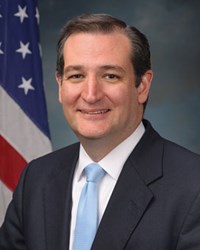Implications of the 2018 mid-terms for the oil and gas industry
In the November 2018 mid-term elections, all 435 seats in the House of Representatives, 35 Senate seats, and 36 governorships were contested. The Democrats won control of the House (Fig. 1), the Republicans strengthened their Senate majority, and the Democrats won a net of seven governorships.

REPUBLICAN SENATE
Republicans increased their slim Senate majority with a net gain of two seats. The Republican-controlled Senate implies that an anti-oil-and-gas (O&G) agenda will face headwinds at the federal level, even as Democrat gains in the House and in the states make such an agenda likely. Republicans retained the administration’s ability to appoint judges and agency officials favorably disposed to O&G policies, and to a regulatory reform agenda.
Bernard McNamee was confirmed to fill the crucial fifth FERC position, and this will facilitate contested natural gas projects. Energy policy has been a bipartisan affair in the Senate Energy and Natural Resources Committee under Chairman Lisa Murkowksi (R-Alaska, Fig. 2) and Ranking Member Maria Cantwell (D-Wash.). They will likely continue work on moderate legislation, but that will have to be reconciled with a Democrat-controlled House. Bipartisanship suffered with the defeat of moderates, including Heidi Heitkamp (D-N.D.). However, a Senate victor, Joe Manchin (D-WV), is one of the few Democrats that is even close to being rational on energy policy.
DEMOCRATS CONTROL THE HOUSE
Democrats won a House majority, gaining 40 seats—their largest net gain since 1974. Divided control of the House and Senate will impede legislative initiatives over the next two years, but a Democrat House majority will pursue aggressive oversight of the Trump administration’s energy and deregulatory policies. Oversight targets include accelerated energy infrastructure permitting, climate regulations, and O&G drilling initiatives, and individual O&G companies also will be investigated.

Ominously, the party platform calls for the elimination of all fossil fuels from society, and the Democrats are “committed to getting 50% of our electricity from ‘clean energy’ sources within a decade.” Speaker of the House Nancy Pelosi (D-Calif.) pledged to enact climate change legislation.
House Democrats wasted no time, and in the first week of the new Congress did the following:
- They introduced seven bills to prevent O&G drilling in federal waters, warning, “We’re not going to sit by and watch as President Trump plunders our oceans for his friends in the big oil companies.” The bills oppose the administration’s plan to open more offshore areas to O&G production.
- Two representatives from California (naturally!) introduced the Climate Solutions Act of 2019, to establish a National Renewable Energy Standard to drive the U.S. to 100% percent renewable energy by 2035, and to reduce GHG emissions to 80% below 1990 levels by 2050. “As one of the defining issues of our time, the global threat of climate change demands an audacious response, and that’s precisely what we introduced today.”
The election results effectively hobbled the administration’s energy and environmental legislative agenda. But the victory gives Democrats little legislative power of their own. Thus, if by some miracle any Democrat-authored House energy bill makes it through the Republican-controlled Senate, President Trump will veto it.
House Democrats now have oversight authority: The ability to hold hearings, request documents, and issue subpoenas. Pelosi has stated “Make no mistake, Democrats will honor our constitutional responsibility to exercise oversight of the Trump administration and get the American people the answers they deserve.” The Democrat-controlled House thus means intense oversight of the administration’s energy and environmental policies, with Democratic committee leaders able to subpoena records and hold public hearings with cabinet officials. The Democrats’ energy agenda will clarify in the coming months, but we should recall that the last time they controlled the House, they passed the atrocious Waxman-Markey CO2 bill.

The election decimated Republicans in the Climate Solutions Caucus, and many Republicans who supported “clean energy policies” are gone. The caucus lost 22 Republicans—half the party’s membership. Republican losses include 14 incumbents, and eight in formerly Republican seats opened up by the departure of caucus members. One caucus member defeated was co-founder Carlos Curbelo (R-Fla.), who sponsored a carbon tax in 2018 (the Republican-controlled House passed a resolution denouncing it). However, the bad news is that the caucus Republicans were mostly replaced by Democrats even more radical on O&G and CO2 issues.
The Democrat chairs of House committees overseeing energy and environmental issues vowed to scrutinize the Trump administration’s actions and bring before them officials, who they contend have escaped adequate oversight. Representatives Eddie Johnson (D-Texas), Raúl Grijalva (D-Ariz.), and Frank Pallone, Jr. (D-N.J.), are heading the committees on Science, Space and Technology; Natural Resources; and Energy and Commerce, respectively, Fig. 3. They have outlined an aggressive agenda to contest the administration’s rollback of President Obama’s energy agenda and to investigate alleged misconduct of officials.
Natural Resources Chairman Rob Bishop (R-Utah) was replaced by Grijalva, who has never seen a well, pipeline, rig, refinery or mine that he did not want to shut down and is a notorious inquisitor of anyone questioning the global warming religion. The League of Conservation Voters (LCV), which rates each Member of Congress for environmental fanaticism, gave Bishop a 2 and Grijalva a 96—enough said. Grijalva stated that he will conduct hearings on a proposed Interior reorganization plan, which he contends will break up some “pretty well-functioning” offices. He warned that he has “a long list of initiatives that have been dormant.”
At the powerful Ways and Means Committee, Chairman Kevin Brady (R-Texas) was replaced by Richard Neal (D-Mass.), who has an LCV rating of 92 and opposes the percentage tax depletion allowance. At the Energy and Commerce Committee, Greg Walden (R-Ore.) was replaced by LCV stalwart Frank Pallone, who opposes opening the Outer Continental Shelf and ANWR to oil drilling; supports a moratorium on offshore oil drilling; opposes O&G “subsidies” (but not renewable energy “incentives”); supports CO2 restrictions; and advocates stricter energy and environmental regulations. Pallone stated, “We have serious concerns with how Trump’s EPA has consistently sided with the special interests over people’s health and the environment, and we will look to restore the environmental protections that have been gutted over the last two years.” He vowed that he would “hold the Trump administration accountable for dangerous policies that make climate change worse.”
Committee chairs have strong oversight authority and could harass administration officials indefinitely. They can enforce deadlines for documents and testimony and invoke subpoena powers to compel testimony. Expect a blizzard of subpoenas for DOE, Interior and EPA officials, and for O&G executives. Energy executives can be hauled before committee members—many elected with green groups’ support—and questioned about their companies’ roles in myriad energy and environmental controversies. ExxonMobil executives may be the first called for allegedly “misleading the public about climate change.” Appropriations also originate in the House, so Democrats could withhold funding from departments or programs over various issues.
Democrats have revived a House committee on climate change—the new Select Committee on the Climate Crisis. Pelosi stated “The climate crisis is the existential threat of our time—a crisis manifested in natural disasters of epic proportions. Congress must work to put an end to the inaction and denial of science that threaten the planet and the future.” The original Select Committee on Energy Independence and Global Warming was dissolved by Republicans in 2011. The committee, founded by Pelosi, was not authorized to advance legislation, but it held hearings to address concerns about CO2, extreme weather, and global warming. (Apparently, Democrats do appreciate irony: In the intervening eight years, and without an “Energy Independence Committee,” the U.S. has become the largest energy producer in the world, an oil exporter, and essentially energy-independent.)
Representative Kathy Castor (D-Fla.) was selected to head the new Climate Committee. The only good news is that it ended a dramatic month-long effort to establish a select committee on a “Green New Deal,” which was led by Alexandria Ocasio-Cortez (D-N.Y.), a self-proclaimed Democratic Socialist and new darling of the left. Castor’s appointment also ignited controversy, as she rejected calls to bar members who accept money from O&G companies from serving on the committee, arguing it would violate free speech rights.
Democrats stated that committees with jurisdiction over energy and environmental issues will spend most of their time conducting oversight. Thus, expect numerous hearings probing the administration’s O&G policies, regulatory reforms and what role energy companies may have played in such decisions as canceling the Paris climate accord, revising the Clean Power Plan and expanding O&G lease sales on public lands.
STATE ELECTION RESULTS
Democrats made substantial gains in gubernatorial races and won control of governorships in Illinois, Kansas, Maine, Michigan, Nevada, New Mexico and Wisconsin. However, Republicans retained control over the governor’s office and state legislatures in the battleground states of Florida, Iowa and Ohio. More than 350 Republican legislators were defeated and, nationwide, 10 winning gubernatorial candidates campaigned on ridding their states of fossil fuels. Thus, many states will be led by governors with an anti-O&G agenda. Destructive anti-energy ballot measures were defeated in Arizona, Washington and Colorado, but succeeded in Nevada and California. Major state results are summarized below.
Alaska. Voters defeated a proposal to strengthen permitting regulations for O&G drilling that could affect salmon habitats. The oil industry worried that it could prohibit developments on the North Slope and elsewhere.
Arizona. Voters rejected an increase in Arizona’s renewable portfolio standard (RPS) to require electric utilities to obtain 50% of electricity from renewables by 2030. This was a major defeat for green activist California billionaire Tom Steyer, who funded the initiative.
California. Voters defeated a proposition that would have repealed a recent 12¢/gal gasoline tax increase and prevented state lawmakers from increasing gasoline taxes without voter approval. Newly elected Gov. Gavin Newsom’s approach to energy issues will make former Gov. Jerry Brown’s policies appear moderate in comparison. Newsom has promised to accelerate “decarbonization” to achieve 100% renewable energy, and to achieve zero diesel emissions by 2030.

Colorado. In one of the most bitterly fought state referenda, voters rejected Proposition 112, which would have required new O&G wells to be located at least 2,500 ft from homes, schools, other buildings, and waterways, Fig. 4. It could have placed 85% of state and private land off-limits in Colorado, which ranks sixth in O&G production. The measure would have set one of the most protective standards in the country and would have crippled an ongoing drilling boom in the state. Democrat Jared Polis was elected governor. He has characterized the U.S. as being “addicted” to fossil fuels and pledged 100% renewable electricity by 2040. The Democrats also won control of the state legislature, and we have thus not seen the end of the Keep it in the Ground movement in Colorado.
Florida. Voters approved a state constitutional amendment that prohibits drilling in state waters along Florida’s shoreline. The amendment will not impact supply, since no drilling currently takes place in state waters, but it prohibits future development. The amendment will not impact the transportation of oil, refined products or LNG through state waters by pipeline or ship, nor future drilling in federal waters.
Michigan. Democrat Gretchen Whitmer was elected governor. She may close Enbridge’s 540,000-bpd Line 5 pipeline, a key route for Canadian crude and NGLs to the Midwest and Ontario. She also has promised to revoke an agreement recently reached between the state and Enbridge to build a utility corridor under the Great Lakes’ Straits of Mackinac that would address environmental safety concerns surrounding the 65-year-old Line 5 and house a future replacement. Canadian pipeline capacity is so constrained that losing any throughput would exacerbate the discount to U.S. prices at which Alberta producers must sell their oil. Whitmer campaigned on a goal of 100% renewable energy for Michigan and will appoint PSC commissioners in 2019 and 2021.
Missouri. Voters rejected an increase of 10¢/gal in the state’s gasoline tax.
Nebraska. Two State PSC commissioners were elected, who favor the Keystone XL pipeline, defeating opponents who oppose the pipeline. The state Supreme Court is reviewing pipeline approval. The outcome of the Supreme Court proceeding could send the decision back to the PSC, where approval is now likely.
Nevada. The enviros achieved their only major success, as voters approved a state constitutional amendment that requires 50% renewable electricity by 2030. This was one of several state-level RPS efforts backed by Tom Steyer’s non-profit NextGen Climate Action and its sole victory.

New Mexico. Democrat Michelle Lujan Grisham was elected governor. She will impose tougher drilling regulations and limits on methane emissions for drillers in the number-three oil-producing state. However, her influence is limited, since most of the state’s O&G production is on federal land. Grisham also has vowed to move “aggressively” to promote renewable energy.
New York. Democrat Gov. Andrew Cuomo, who pledged to accelerate renewables, was re-elected, and the state Senate flipped to Democrat control. The combination of Cuomo and a Democrat Senate will likely revive ambitious renewable energy legislation and require state agencies to apply a climate test to permitting.
Texas. In one of the highest-profile races of the mid-terms, Republican Senator Ted Cruz (barely) won re-election, Fig. 5. He is one of the O&G industry’s major defenders in the U.S. Senate.
Washington. Voters, for the second time, rejected a carbon tax. It would have been the first such tax in the U.S. and, if passed, was predicted to encourage similar efforts in other states. The industry, led by BP America and Phillips 66, aggressively campaigned to defeat the proposal.
THE BOTTOM LINE
With a Democrat-controlled House containing an increased number of left-leaning and green-oriented representatives, increased Democrat presence among governors and state legislatures, and an energized and well-funded environmental, anti-O&G movement, it is going to be a long two years for the O&G industry. The industry will have to fight hard, merely to preserve the gains it has made. We have been warned. ![]()

- The last barrel (February 2024)
- E&P outside the U.S. maintains a disciplined pace (February 2024)
- U.S. producing gas wells increase despite low prices (February 2024)
- Executive viewpoint: TRRC opinion: Special interest groups are killing jobs to save their own (February 2024)
- U.S. drilling: More of the same expected (February 2024)
- U.S. oil and natural gas production hits record highs (February 2024)
- Applying ultra-deep LWD resistivity technology successfully in a SAGD operation (May 2019)
- Adoption of wireless intelligent completions advances (May 2019)
- Majors double down as takeaway crunch eases (April 2019)
- What’s new in well logging and formation evaluation (April 2019)
- Qualification of a 20,000-psi subsea BOP: A collaborative approach (February 2019)
- ConocoPhillips’ Greg Leveille sees rapid trajectory of technical advancement continuing (February 2019)


